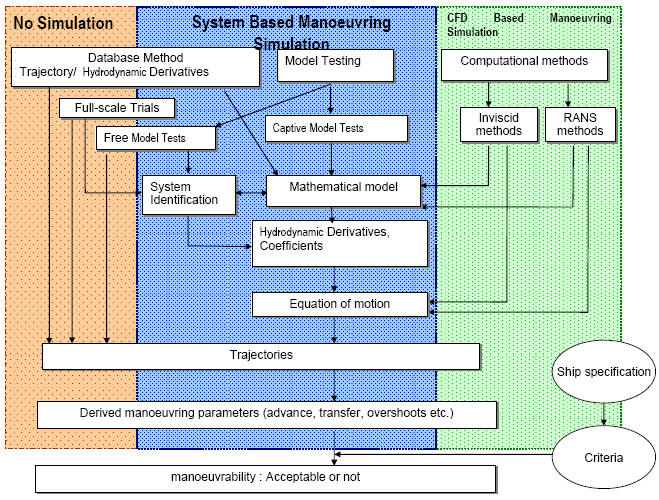
Predicting ship maneuvering performance has been one of the most challenging topics in ship hydrodynamics research because of its highly complex unsteady and non-linear nature. Due to the lack of analytical methods for ship maneuverability, maneuvering predictions have relied on either empirical methods using database or experimental model tests.
The database method (Wagner Smitt, 1970 and 1971, Norrbin, 1971, Inoue et al., 1981, Clarke et al., 1983, Oltmann, 1992, Kijima, 1990 and 1993, Kijima and Nakiri, 2003, Lee et al., 2003) is simple and quick to use, but this method is only effective when the dimensions and frame lines of the vessel are in the database.
Experimental model test methods (StrÝm-Tejsen, J. and Chislett, M.S., 1966, Gertler, 1966, Yoshimura, 2003, Kim et al., 2003), including free model tests and captive model tests such as oblique towing tests, rotating arm tests, circular motion tests, and planar motion mechanism (PMM) tests, are based on mathematical modeling of the ship motion equations. From these model tests, which are the most traditional methods, hydrodynamic derivatives and coefficients of the mathematic model can be obtained rather easily, but test results and vessel geometry tend to be proprietary and outside the public domain.
Recently, computational fluid dynamics (CFD) based methods have shown promise for computing complex hydrodynamic forces for steady and unsteady maneuvers.

Significant progress has been made toward this goal by applying Reynolds-averaged Navier-Stokes (RANS)-based CFD codes to static maneuvers (Tahara et al., 2002, Simonsen and Stern, 2003a, b and c, Tanaka and Kimura, 2003, El Moctar, 2001, Cura Hochbaum and Vogt, 2003), dynamic maneuvers (Burg and Marcum, 2003, Di Mascio and Broglia, 2003, Di Mascio et al., 2004, Kim and Rhee, 2002), and trajectories (Jensen et al., 2004, Pankajakshan et al., 2002) with generally good agreement with experimental data.
Although RANS methods are considered promising, they are still challenged by difficulties associated with time-accurate schemes, six degree of freedom (6DOF) ship motions, implementation of complex appendages, propulsors and environmental effects such as waves and shallow water. Furthermore, to be accepted as a credible simulation tool by end users such as industry or navy, and ultimately to be used for simulation based design (SBD), they are required to be verified and validated (V&V) for practical ship geometries and conditions. However, V&V and benchmarking of unsteady RANS for ship hydrodynamics remains a challenge due in part to lack of available experimental fluid dynamics (EFD) validation data, especially for ship motions and maneuvering.
As an international effort to meet this demand, recently the Maneuverings Committee (MC) of the 24th International Towing Tank Conference (ITTC) designated four model scale hull forms (Japanese SR-221 tanker, Korean KRISO tanker (KVLCC), Korean KRISO container ship (KCS), and the US Navy DDG51 frigate) as benchmark cases and is accumulating well-documented benchmarking EFD data with full uncertainty assessment (UA) following standard procedures. Recognizing a need for more ship maneuvering data for expanding the database, support of CFDSHIP-IOWA V&V efforts, and collaborative work with other institutions has led to the design, construction, and installation of a PMM carriage for the IIHR towing tank.
The measurement system features a custom design comprised of a PMM for captive model testing with an integrated stereoscopic particle image velocimetry (SPIV) for procuring instantaneous and phase-averaged flow maps. The PMM consists of a main PMM sway/yaw motion mechanism unit, roll/pitch/heave free/fixed mount, and three component load cell; and sub PMM sway/yaw motion mechanism unit, SPIV traverse, and linked motion mechanism.
These benchmark data will be
available at the SIMMAN2008
international workshop.
The objective of the present study is to provide benchmark EFD data and UA for DTMB model 5512, a geosym (Lpp = 3.048 m) of DTMB model 5415 for the US Navy DDG51 frigate which is one of the 24th ITTC MC designated benchmark hull forms.
The EFD data includes complete time histories of global forces and moment measurements and PIV local flow velocity and turbulent Reynolds stress field measurements together with their UA.
The approach is complementary CFD, EFD, and UA. CFD is used to guide EFD, EFD is used for validation and model development, and lastly CFD is validated and fills in sparse data for complete documentation and diagnostics of the flow.
Forces and moments and motions are measured for several towing speeds and mounting conditions for static drift and dynamic maneuvering tests. Several drift angles, frequencies, amplitudes, and yaw rates are investigated.
Phase-Averaged Stereo PIV flowfield is measured for a single pure yaw and pure sway test condition.
Results will be presented for both static and dynamic PMM, in the latter case including pure sway, pure yaw, and yaw and drift tests.
The current project builds on previous work including forward-speed diffraction problem (Gui et al. 2001; Gui et al. 2002; Longo et al. 2005), pitch and heave motions (Irvine et al., 2006), and investigations of roll motions with and without bilge keels (Bishop et al. 2004; Felli et al. 2004; Irvine et al. 2004).
The overall focus is on benchmark CFD validation data for surface combatant DTMB model 5415 (Stern et al., 2000).